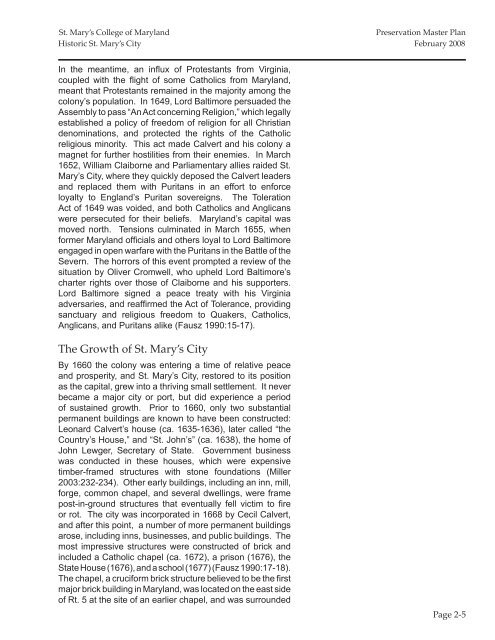St. Mary's College of Maryland Preservation Master Plan
St. Mary's College of Maryland Preservation Master Plan
St. Mary's College of Maryland Preservation Master Plan
- No tags were found...
Create successful ePaper yourself
Turn your PDF publications into a flip-book with our unique Google optimized e-Paper software.
<strong>St</strong>. Mary’s <strong>College</strong> <strong>of</strong> <strong>Maryland</strong><strong>Preservation</strong> <strong>Master</strong> <strong>Plan</strong>Historic <strong>St</strong>. Mary’s City February 2008In the meantime, an influx <strong>of</strong> Protestants from Virginia,coupled with the flight <strong>of</strong> some Catholics from <strong>Maryland</strong>,meant that Protestants remained in the majority among thecolony’s population. In 1649, Lord Baltimore persuaded theAssembly to pass “An Act concerning Religion,” which legallyestablished a policy <strong>of</strong> freedom <strong>of</strong> religion for all Christiandenominations, and protected the rights <strong>of</strong> the Catholicreligious minority. This act made Calvert and his colony amagnet for further hostilities from their enemies. In March1652, William Claiborne and Parliamentary allies raided <strong>St</strong>.Mary’s City, where they quickly deposed the Calvert leadersand replaced them with Puritans in an effort to enforceloyalty to England’s Puritan sovereigns. The TolerationAct <strong>of</strong> 1649 was voided, and both Catholics and Anglicanswere persecuted for their beliefs. <strong>Maryland</strong>’s capital wasmoved north. Tensions culminated in March 1655, whenformer <strong>Maryland</strong> <strong>of</strong>ficials and others loyal to Lord Baltimoreengaged in open warfare with the Puritans in the Battle <strong>of</strong> theSevern. The horrors <strong>of</strong> this event prompted a review <strong>of</strong> thesituation by Oliver Cromwell, who upheld Lord Baltimore’scharter rights over those <strong>of</strong> Claiborne and his supporters.Lord Baltimore signed a peace treaty with his Virginiaadversaries, and reaffirmed the Act <strong>of</strong> Tolerance, providingsanctuary and religious freedom to Quakers, Catholics,Anglicans, and Puritans alike (Fausz 1990:15-17).The Growth <strong>of</strong> <strong>St</strong>. Mary’s CityBy 1660 the colony was entering a time <strong>of</strong> relative peaceand prosperity, and <strong>St</strong>. Mary’s City, restored to its positionas the capital, grew into a thriving small settlement. It neverbecame a major city or port, but did experience a period<strong>of</strong> sustained growth. Prior to 1660, only two substantialpermanent buildings are known to have been constructed:Leonard Calvert’s house (ca. 1635-1636), later called “theCountry’s House,” and “<strong>St</strong>. John’s” (ca. 1638), the home <strong>of</strong>John Lewger, Secretary <strong>of</strong> <strong>St</strong>ate. Government businesswas conducted in these houses, which were expensivetimber-framed structures with stone foundations (Miller2003:232-234). Other early buildings, including an inn, mill,forge, common chapel, and several dwellings, were framepost-in-ground structures that eventually fell victim to fireor rot. The city was incorporated in 1668 by Cecil Calvert,and after this point, a number <strong>of</strong> more permanent buildingsarose, including inns, businesses, and public buildings. Themost impressive structures were constructed <strong>of</strong> brick andincluded a Catholic chapel (ca. 1672), a prison (1676), the<strong>St</strong>ate House (1676), and a school (1677) (Fausz 1990:17-18).The chapel, a cruciform brick structure believed to be the firstmajor brick building in <strong>Maryland</strong>, was located on the east side<strong>of</strong> Rt. 5 at the site <strong>of</strong> an earlier chapel, and was surroundedPage 2-5
















